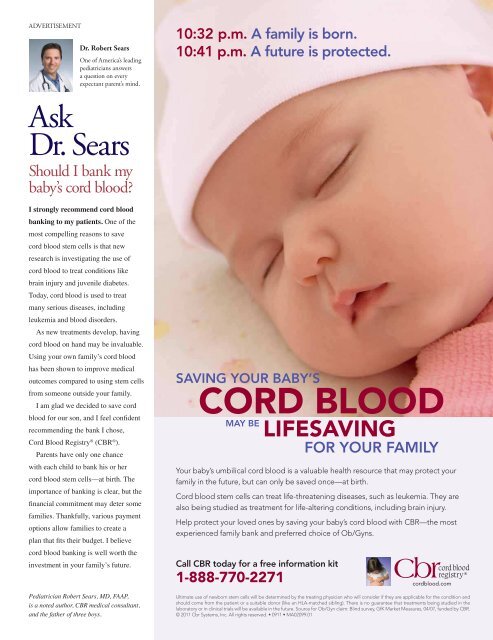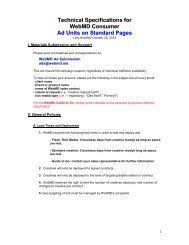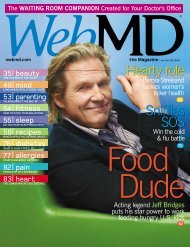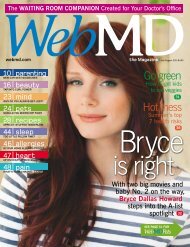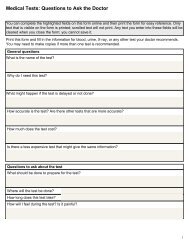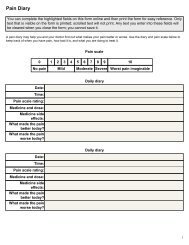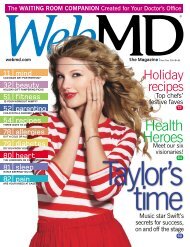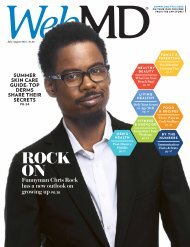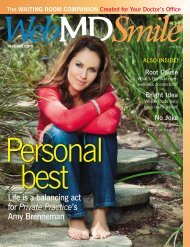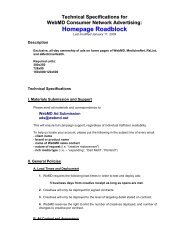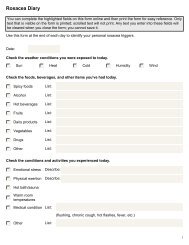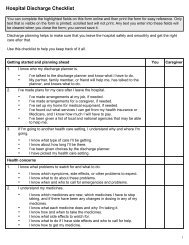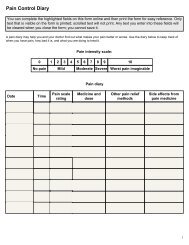Create successful ePaper yourself
Turn your PDF publications into a flip-book with our unique Google optimized e-Paper software.
ADVERTISEMENT<br />
Dr. Robert Sears<br />
One of America’s leading<br />
pediatricians answers<br />
a question on every<br />
expectant parent’s mind.<br />
10:32 p.m. A family is born.<br />
10:41 p.m. A future is protected.<br />
ask the experts<br />
Your questions answered<br />
Ask<br />
Dr. Sears<br />
Should I bank my<br />
baby’s cord blood?<br />
I strongly recommend cord blood<br />
banking to my patients. One of the<br />
most compelling reasons to save<br />
cord blood stem cells is that new<br />
research is investigating the use of<br />
cord blood to treat conditions like<br />
brain injury and juvenile diabetes.<br />
Today, cord blood is used to treat<br />
many serious diseases, including<br />
leukemia and blood disorders.<br />
As new treatments develop, having<br />
cord blood on hand may be invaluable.<br />
Using your own family’s cord blood<br />
has been shown to improve medical<br />
outcomes compared to using stem cells<br />
from someone outside your family.<br />
I am glad we decided to save cord<br />
blood for our son, and I feel confident<br />
recommending the bank I chose,<br />
Cord Blood Registry ® (CBR ® ).<br />
Parents have only one chance<br />
with each child to bank his or her<br />
cord blood stem cells—at birth. The<br />
importance of banking is clear, but the<br />
financial commitment may deter some<br />
families. Thankfully, various payment<br />
options allow families to create a<br />
plan that fits their budget. I believe<br />
cord blood banking is well worth the<br />
investment in your family’s future.<br />
SAVING YOUR BABY’S<br />
CORD BLOOD<br />
MAY BE<br />
LIFESAVING<br />
FOR YOUR FAMILY<br />
Your baby’s umbilical cord blood is a valuable health resource that may protect your<br />
family in the future, but can only be saved once—at birth.<br />
Cord blood stem cells can treat life-threatening diseases, such as leukemia. They are<br />
also being studied as treatment for life-altering conditions, including brain injury.<br />
Help protect your loved ones by saving your baby’s cord blood with CBR—the most<br />
experienced family bank and preferred choice of Ob/Gyns.<br />
on the cover: Alison Dyer/CPi Syndication; left: Radius/Glow Images; CulturaRF/Glow Images<br />
Safe Keeping How to make sure baby stays out of harm’s way<br />
Q How should I babyproof my nursery?<br />
A To start, be sure that your crib’s bars are no more than 2 3/8<br />
inches apart (so your baby doesn’t get caught between them) and<br />
that your crib does not have a drop-side rail (so your baby doesn’t<br />
get trapped between the crib rail and the mattress). Keep pillows,<br />
blankets, and loose stuffed animals out of the crib until your baby<br />
is at least 6 months old as they can suffocate her (you can keep her<br />
warm with thick pajamas when she’s sleeping). Be sure the mattress<br />
fits snugly against the crib sides. And although they’re adorable, it’s<br />
best to forego crib bumpers. Young babies can suffocate in them, and<br />
older babies step on them to climb out of their cribs.<br />
Your changing table should have four raised sides and a strap to<br />
hold baby in. Keep all your supplies within arm’s reach. That way,<br />
you won’t have to<br />
turn away from the<br />
changing table, even<br />
for a second.<br />
Once your baby<br />
gets mobile—by<br />
scooting, rolling, or<br />
crawling—be sure<br />
the entire room is<br />
babyproofed. Electrical<br />
outlets need<br />
childproof covers,<br />
sharp furniture<br />
corners should be<br />
padded, and curtain<br />
cords need to<br />
be shortened or<br />
tied around special<br />
brackets so your<br />
baby can’t strangle<br />
in them. And to keep<br />
your little one from<br />
pulling furniture<br />
over on himself as<br />
he learns to climb,<br />
anchor all heavy<br />
pieces to the wall.<br />
Did you<br />
know?<br />
NAP TO IT<br />
Letting your baby<br />
skip naps not<br />
only will make<br />
him (and you)<br />
miserable during<br />
the day, but also<br />
will worsen his<br />
sleep at night.<br />
“In their first two<br />
months, babies<br />
often don’t<br />
have a sleep<br />
pattern down<br />
yet,” says Carole<br />
Kline, MS, RN,<br />
CPNP. “That’s<br />
perfectly normal.<br />
Eventually,<br />
though,<br />
their sleep<br />
consolidates<br />
toward all-night<br />
sleeping.”<br />
Q Once my baby is born, how will<br />
I know how much food to give her?<br />
A Babies are very good at expressing their<br />
needs. You just have to learn the signs.<br />
Let’s start with hunger. These days, most<br />
parents feed their babies on demand, meaning<br />
when they’re hungry. How will you know?<br />
Newborns signal hunger several ways, including<br />
opening and closing their mouths, sucking<br />
on their hands, “rooting” or rubbing their<br />
heads against mom’s chest, and crying. If your<br />
baby tends to sleep a lot, wake her every two<br />
hours to make sure she eats.<br />
Your baby’s signals that she’s had enough<br />
to eat will also be clear. She may turn her head<br />
away from the breast or bottle, fall asleep, or<br />
start crying if you keep trying to make her<br />
eat. Also, if you are nursing, your breasts will<br />
feel softer after she nurses because she’s emptying<br />
them as she eats.<br />
Most babies lose a little weight (up to 10%)<br />
in the first week but gain about 5 to 10 ounces<br />
per week through the first month. A baby getting<br />
enough to eat should have seven or eight<br />
wet diapers and one or more stools per day.<br />
Call CBR today for a free information kit<br />
1-888-770-2271<br />
cordblood.com<br />
Sara DuMond, MD<br />
<strong>WebMD</strong> BABY CARE EXPERT<br />
Hansa Bhargava, MD<br />
<strong>WebMD</strong> BABY CARE EXPERT<br />
Pediatrician Robert Sears, MD, FAAP,<br />
is a noted author, CBR medical consultant,<br />
and the father of three boys.<br />
Ultimate use of newborn stem cells will be determined by the treating physician who will consider if they are applicable for the condition and<br />
should come from the patient or a suitable donor (like an HLA-matched sibling). There is no guarantee that treatments being studied in the<br />
laboratory or in clinical trials will be available in the future. Source for Ob/Gyn claim: Blind survey, GfK Market Measures, 04/07, funded by CBR.<br />
© 2011 Cbr Systems, Inc. All rights reserved. • 0911 • MA02099.01<br />
Ask the experts all your newborn-care questions.<br />
<strong>WebMD</strong>.com<br />
September 2011 | <strong>WebMD</strong>Baby 49


